My late 1850s or early 1860s brown taffeta day dress is inspired by this beautiful 1855-7 brown silk day dress which is trimmed with black velvet bands and fringe.
Brown together with black was a popular choice for silk day dresses in the 1850s and 1860s: 1855–58 brown and black silk day dress and 1860s brown and black silk brocade day dress.
I used brown non-historically accurate polyester taffeta – silk taffeta is so expensive 🙁 – wide black velvet ribbon and black fringe. I’d planned to trim the whole skirt with velvet ribbon and fringe like the dress in the V&A museum but I made the dress for a special event and ran out of time. 😉 And I would’ve loved to replicate the pretty black silk fringe with copper-colored chenille pompoms, but I couldn’t find anything similar.
I made a matching hat for the outfit, similar to the hat in this 1865 photograph. The hat is made with the same taffeta over a stiffly starched fabric foundation. The edge is bound with black velvet ribbon, and decorated with a taffeta bow which is trimmed with black fringe. I think about trimming the hat with a black ostrich feather. What do you think? And my hairstyle is inspired by this 1870 braided updo.
The bodice has pagoda sleeves which are usually worn with engageantes (false undersleeves). I’m wearing the dress over my usual underwear: chemise, corset, crinoline and my Victorian ruffled petticoat.
Victorian day dresses were always worn with separate collars: Here I’m wearing my handsewn cotton and lace collar which is fastened with my antique Victorian gold and onyx brooch.
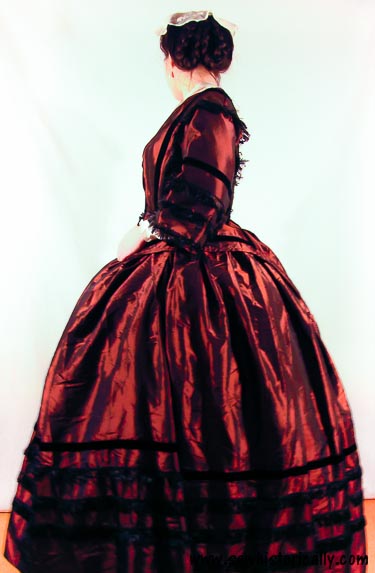
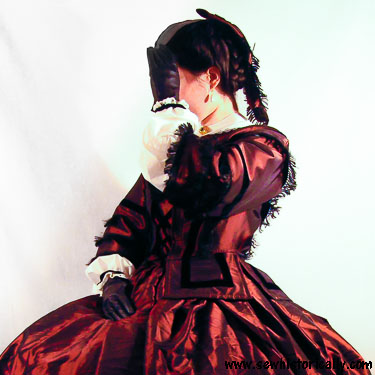
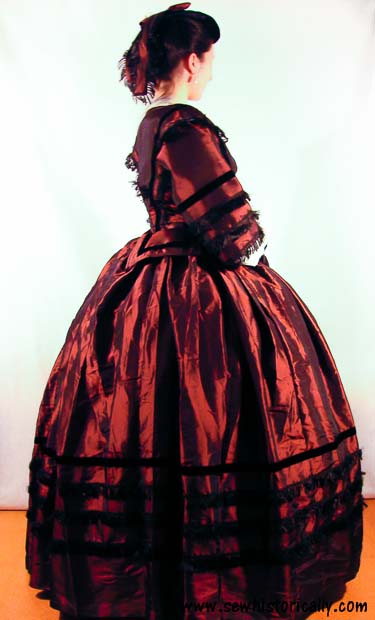
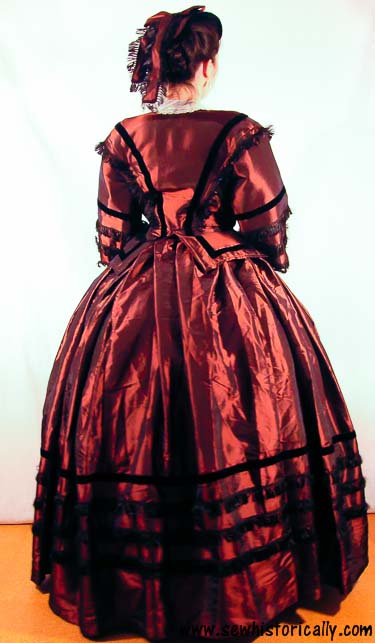
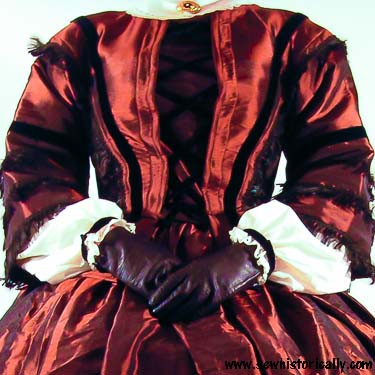
Absolutely gorgeous. I’m so glad we don’t have to wear all those underlayers and endure tight lacing today. Having grooves in your liver to have a handspan waist just doesn’t cut it for me!!!
Thanks, Kathy! But tight lacing was frowned upon in the Victorian era – it’s just exaggerated in novels. Before knitwear became fashionable, corsets were necessary to keep the bodice wrinkle-free.
What a gift you have! The dress looks absolutely amazing!! How fun!
Thanks for sharing!
Thank you, Karen!
That dress is just stunning, Lina! Thanks for sharing at Vintage Charm-pinned!
Thanks, Cecilia! 🙂
That dress is stunning Lina – absolutely beautiful you are a talented seamstress
Thanks, Amber! 🙂
UNBELIEVABLE!!! (And that is deserving of all caps.)
I have no words…
Thank you, Rebecca!
Wow! So hard to believe ladies dressed so elegantly everyday! Reminds me of Gone With the Wind Era. Thanks for sharing at Home Sweet Home!
Thanks, Sherry!
Oh my goodness, what a beautiful dress! You are so talented! I love your hairstyle as well. I can see why you used polyester instead of silk – I can only imagine how costly it would be. You definitely can’t tell from the photos. Love the colour as well. Thank you so much for sharing your handwork with us at the Hearth and Soul Link Party.
Thanks for your lovely comment, April! 🙂
Oh good grief, this is A MAZE ING Lina, It is stunning. I imagine it is a little uncomfortable with all that going on but it must feel SO elegant. Wowza!
Thanks, Julie! 😀 But one feels less elegant when one has to go through a door: doors today are too small for a crinoline! 😉
Wow, the dress is amazing. I love the dresses of that era, so elegant and refined. The color reminds me of a fall day. Thanks for sharing on Sunday’s Best. I love your talent.
Thanks, Rhonda! 🙂
Wow, totally blown away by your talent and interest in this historical period of fashion. I found it so interesting though, and how fashion evolves, and have often wondered how my ancestors dressed. Goodness, and you made this dress! It’s beautiful! I looked at your other links too. I never really knew what a “chemise” was, though I’ve heard of it. And didn’t understand the true meaning of “drawers.” I wonder how those ladies went to the bathroom???
Thanks for your lovely comment, Florence! 🙂 And the ladies could go to the bathroom because Victorian drawers had an open crotch seam. 😉 It’s really odd but in the Victorian era, it was even considered indecent and unhygienic for women’s drawers to have a closed crotch seam!
I have no words Lina. That dress is amazing. Just WOW!!!!
Thanks, Michelle! 🙂
You sew so wonderfully and creatively, I’m absolutely loving looking through your posts and images. I love the simpler day dresses and caps, and the lace caps are beautiful, but this whole outfit is just irresistible, beyond stunning. Did you end up putting the peacock feather on the cap?